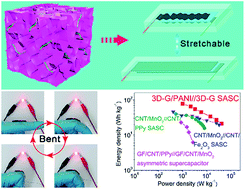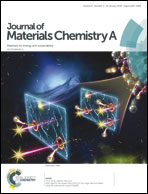A three-dimensional graphene framework-enabled high-performance stretchable asymmetric supercapacitor†
Abstract
The construction of flexible and stretchable supercapacitors with high energy density and superior stability is critical for modern wearable electronics but still remains considerably challenging. Herein we develop an ultrahigh-performance stretchable asymmetric supercapacitor (SASC) by using electrically and mechanically robust three-dimensional graphene frameworks as electrodes for the first time, in which three-dimensional graphene and a deliberately designed three-dimensional graphene/polyaniline composite are employed as the anode and cathode, respectively. The newly developed SASCs show the highest energy density of 77.8 W h kg−1 among all reported stretchable supercapacitors, and also deliver exceptional cycling stability with 95.6% capacitance retention after 10 000 charge–discharge cycles and excellent electrochemical durability with 91.2% capacitance retention after 100 stretching cycles at a large strain of 100%. The practicability of our SASC has been further demonstrated by efficiently powering a light-emitting diode indicator (1.8 V, 10 mA) under repeated stretching of a SASC mounted on a finger. Moreover, by connecting three SASCs in series, the tandem device can even drive an STC89C51RC microcontroller-based complex circuit (5.0 V) to light a liquid crystal display.



 Please wait while we load your content...
Please wait while we load your content...